Sundararaja D. The Discrete Fourier Transform. Theory, Algorithms and Applications
Подождите немного. Документ загружается.

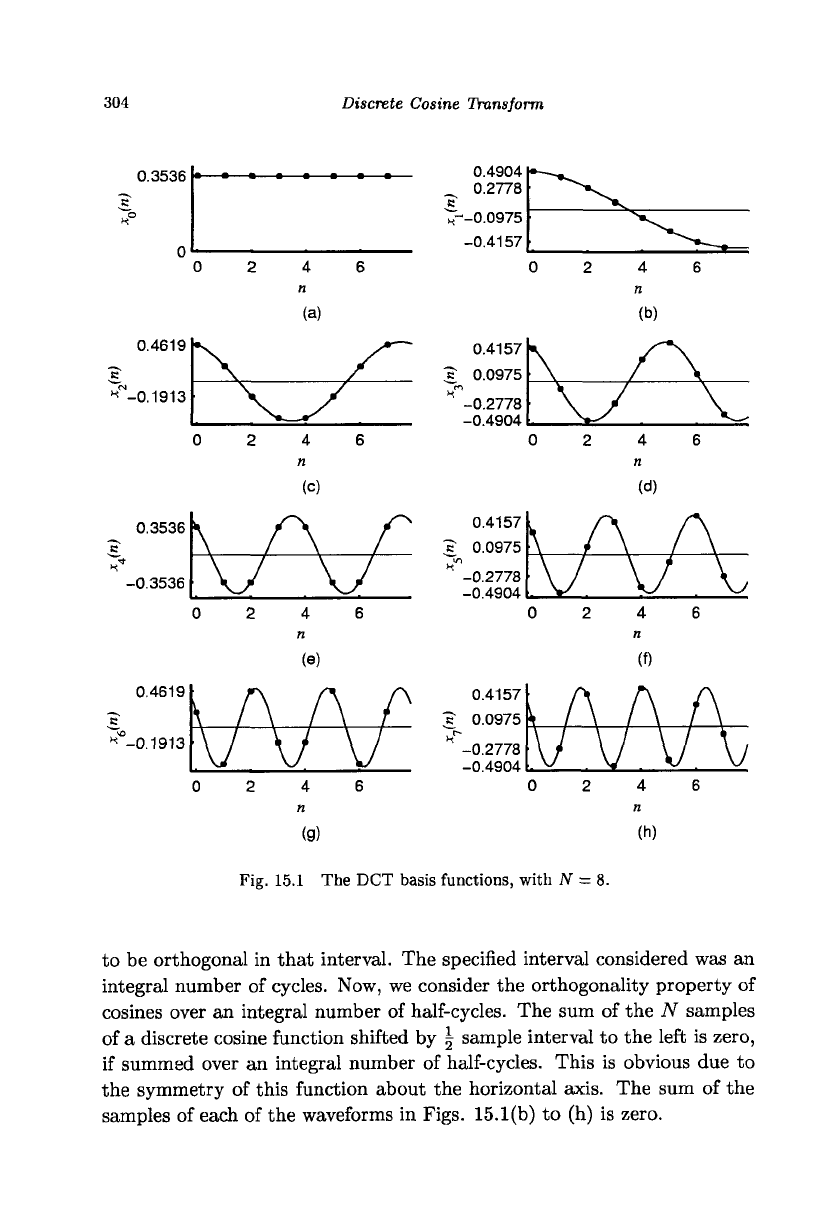
304
Discrete Cosine Transform
0.3536
0.4619
* -0.1913
(c) (d)
0.3536
-0.3536
0
* -0.
4619
1913
(e)
0.4157
; 0.0975
in
-0.2778
-0.4904
0.4157
0.0975
-0.2778
-0.4904
(9)
Fig. 15.1 The DCT basis functions, with AT = 8.
(h)
to be orthogonal in that interval. The specified interval considered was an
integral number of cycles. Now, we consider the orthogonality property of
cosines over an integral number of half-cycles. The sum of the N samples
of a discrete cosine function shifted by \ sample interval to the left is zero,
if summed over an integral number of half-cycles. This is obvious due to
the symmetry of this function about the horizontal axis. The sum of the
samples of each of the waveforms in Figs. 15.1(b) to (h) is zero.
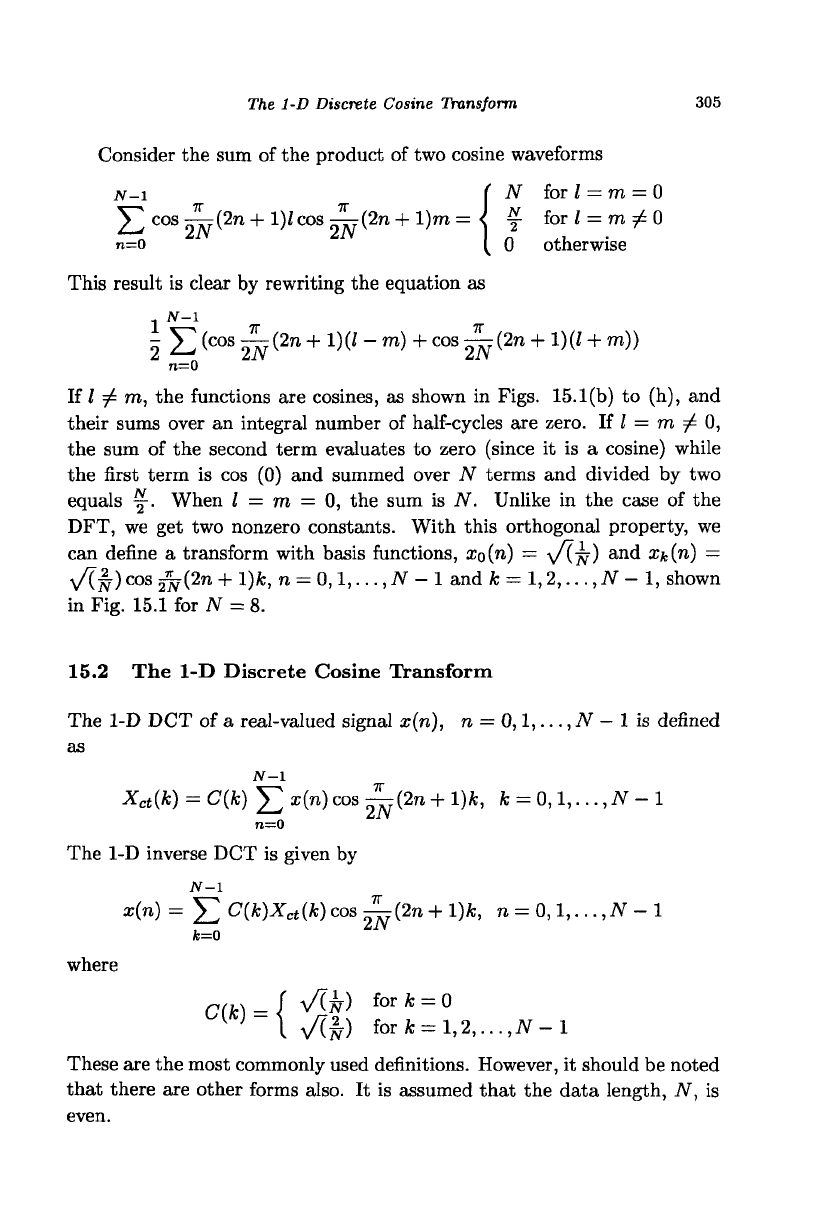
The 1-D Discrete Cosine Transform
305
Consider the sum of the product of two cosine waveforms
jv-i f N for I = m = 0
E
cos ^(2n +
1)1
cos r^r(2n + l)m = < £ for
Z
= m ^ 0
n=o ^ 0 otherwise
This result is clear by rewriting the equation as
1
N_1
2 ^
(cOS
2^T
(2n + 1)(
' "
m) + C
°
S
2^
(2n + 1)(Z + m))
n=0
If I 7^ m, the functions are cosines, as shown in Figs. 15.1(b) to (h), and
their sums over an integral number of half-cycles are zero. If / = m ^ 0,
the sum of the second term evaluates to zero (since it is a cosine) while
the first term is cos (0) and summed over N terms and divided by two
equals y. When I = m = 0, the sum is N. Unlike in the case of the
DFT, we get two nonzero constants. With this orthogonal property, we
can define a transform with basis functions, Xo(n) =
y/ijf)
and Xfc(n) —
^/(jf) cos 2^(2n + l)jfe, n =
0,1,...,
N - 1 and k =
1,2,...,
N - 1, shown
in Fig. 15.1 for N = 8.
15.2 The 1-D Discrete Cosine Transform
The 1-D DCT of a real-valued signal x(n), n =
0,1,...,
N
—
1 is defined
as
N-l
X
ct
{h)
=
C{k)
J2
<
n
)
cos
2^(2" +
!)
fc
.
k =
0,l,...,N-l
n=0
The 1-D inverse DCT is given by
JV-l
<
n
)= ^C^Xctik)cos £-{2n + \)k, n =
0,1,..
.,N - 1
2iV"
fe=o
where
c(fc) =
{$I)
t
°'
k=
°
f) for* =
1,2,...,
JV-l
These are the most commonly used definitions. However, it should be noted
that there are other forms also. It is assumed that the data length, N, is
even.

306
Discrete Cosine Transform
Computation of the DCT using the DFT
Splitting the summation in the DCT denning equation into that of the
even-indexed and odd-indexed input samples, we get
Xct(k) = CW{$>(2n)cos^:(2(2n) + l)fc
n=0
+ J^
x
(
2n
+
!)
cos
^ (
2
(
2n
+ !) + !)*}
n=0
By reversing the order of the computation of the products in the second
summation, we get
= C(k){ 53 x(2n) cos ^(2(2n) + l)fc
n=0
JV-1
+ 53 ^(2^ - 2n - 1) cos ^(2(2^ - 2n - 1) + l)Jfe}
Simplifying, we get
f-
1
„ j JV-i
2?r
j
= C(*){ 53 *(2n) cos -^ (n + -)fc + 53 x(2iV - 2n - 1) cos -^ (n + -)*}
n=0
n=
£
Using the rearrangement of the data
xo(n)~S
X{2n)
' » = 0.1.-.f-l
^W-j x(2JV-2n-l),
n
=f,f+
1,...,7V-1
and combining the two summations, we get
X
ct
(k)
= C(k) 53 ^o(n) cos — (n + ^)k
n=0
We illustrate the operation of this equation with a specific example. The
computation of X
C
{(1), with N = 8, involves the sum of products of the
basis function, 0.5cos ^(n + |), and the input data shown, respectively, in
Figs.
15.2(a) and (b). The coefRcient can also be computed by the sum of
product of the functions shown in Figs. 15.2(c) and (d). As the cosine wave
is even-symmetric, a full cycle of the waveform, 0.5cos ^(n + |), can be
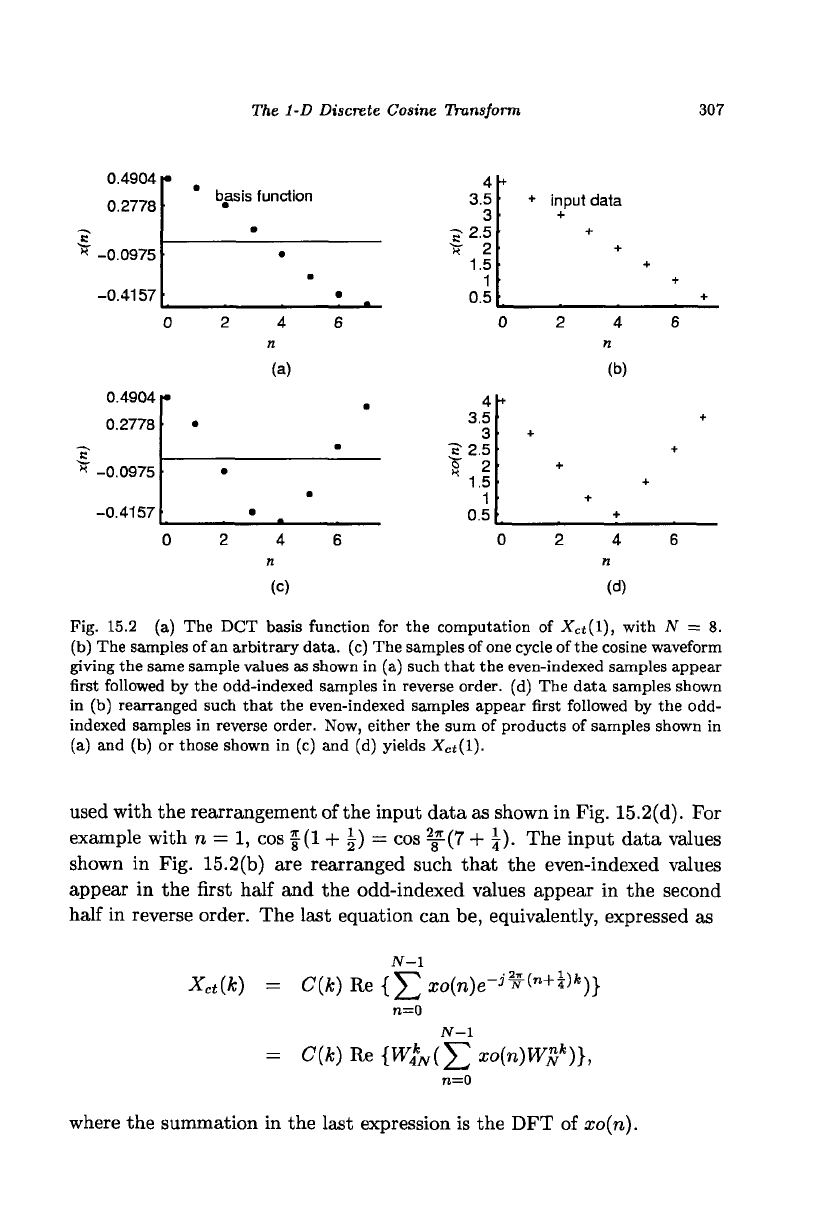
The 1-D Discrete Cosine Transform
307
0.4904
0.2778
c
"* -0.0975
-0.4157
•
0
0.4904
0.2778
1?
H
-0.0975
-0.4157
•
0
bas
•
2
•
•
2
s function
•
•
•
4
n
(a)
•
•
4
n
(c)
•
6
•
6
4
3.5
3
1?2.5
V 2
1.5
1
0.5
+
0
4
3.5
3
•5-2.5
1.5
1
0.5
+
0
+
+
input data
+
2
+
2
+
+
4
n
(b)
+
+
4
n
(d)
+
+
+
6
+
+
+
6
Fig. 15.2 (a) The DCT basis function for the computation of
X
c
t{\),
with N = 8.
(b) The samples of an arbitrary data, (c) The samples of
one
cycle of the cosine waveform
giving the same sample values as shown in (a) such that the even-indexed samples appear
first followed by the odd-indexed samples in reverse order, (d) The data samples shown
in (b) rearranged such that the even-indexed samples appear first followed by the odd-
indexed samples in reverse order. Now, either the sum of products of samples shown in
(a) and (b) or those shown in (c) and (d) yields X
ct
(l).
used with the rearrangement of the input data as shown in Fig. 15.2(d). For
example with n = 1, cos f
(1
+ \) = cos ^(7 + \). The input data values
shown in Fig. 15.2(b) are rearranged such that the even-indexed values
appear in the first half and the odd-indexed values appear in the second
half in reverse order. The last equation can be, equivalently, expressed as
JV-l
X
ct
(k)
= C{k)Re{Y^xo(n)e~
j¥{n+i)k
)}
n=0
iV-1
= C(k) Re {W?
N
(J2 xo(n)W%
k
)},
where the summation in the last expression is the DFT of xo(n).

308 Discrete Cosine Transform
Example 15.1 Compute the DCT,
X
ct
{k),
of x(n) =
{2,1,0,3}.
Com-
pute x(n) back from Xctik).
Solution
Form the sequence xo(n) =
{2,0,3,1}.
Compute the DFT of xo(n), XO(k) —
{6,
—1
+
j,
4,
—1 —
j}. The twiddle factors are
Wfe = {1,0.92 - jO.38,0.71 - jO.71,0.38 - j'0.92}
Multiplying XO(k), term by term, by
W*Q
and taking the real parts, we
get {6.0,-0.54,2.83,-1.31}. A more efficient procedure for this step is
as follows. As the DFT is conjugate-symmetric, if XO(k) = a + jb, then
XO(N
—
k) = a
—
jb. The twiddle factors are related in the following way.
If W*
N
= c + jd, then W\
N
~ = —d
—
jc. Therefore, the products are
related.
(a+jb)(c + jd) = (ac-bd)+j(ad + bc)
(a
—
jb)(—d
—
jc) =
—
(ad + be)
—
j (ac
—
bd)
The imaginary part of the product
W%
N
XO(k)
in the first half is the nega-
tive of the value of the real part with index N
—
k. Therefore, multiplication
with the twiddle factors over half the range is sufficient. Now,
X^k)
= C(fc){6.0, -0.54,2.83, -1.31} = {3.0, -0.38,2.0, -0.92}
The inverse: We trace the steps backwards. Multiply X
c
tik) by constants
for
A;
= 0 and J\ for other values of k to get {1.5,
-0.27,1.41,
-0.65}.
Due to the property mentioned above, the complex signal, W*
6
XOik), can
be constructed with a scale factor as
{1.5,
-0.27 + jO.65,1.41 -
jl.41,
-0.65 + jO.27}
Now, XOik) can be computed with a scale factor as
^{1.5,
-0.27 + jO.65,1.41 -
jl.41,
-0.65 + jO.27}
= {1.5, -0.50 + jO.50,2, -0.50 - jO.50}
These values have been normalized for DCT. For taking the IDFT the first
value must be multiplied by JV = 4 and other values by y = 2 (Note
that the number of multiplication by constants can be minimized in the
implementation of the algorithm.) to get XOik) = {6, -1 + j,4, -1
—
j}.
Computing the IDFT of XOik), we get xoin) =
{2,0,3,1}.
The first half
vT
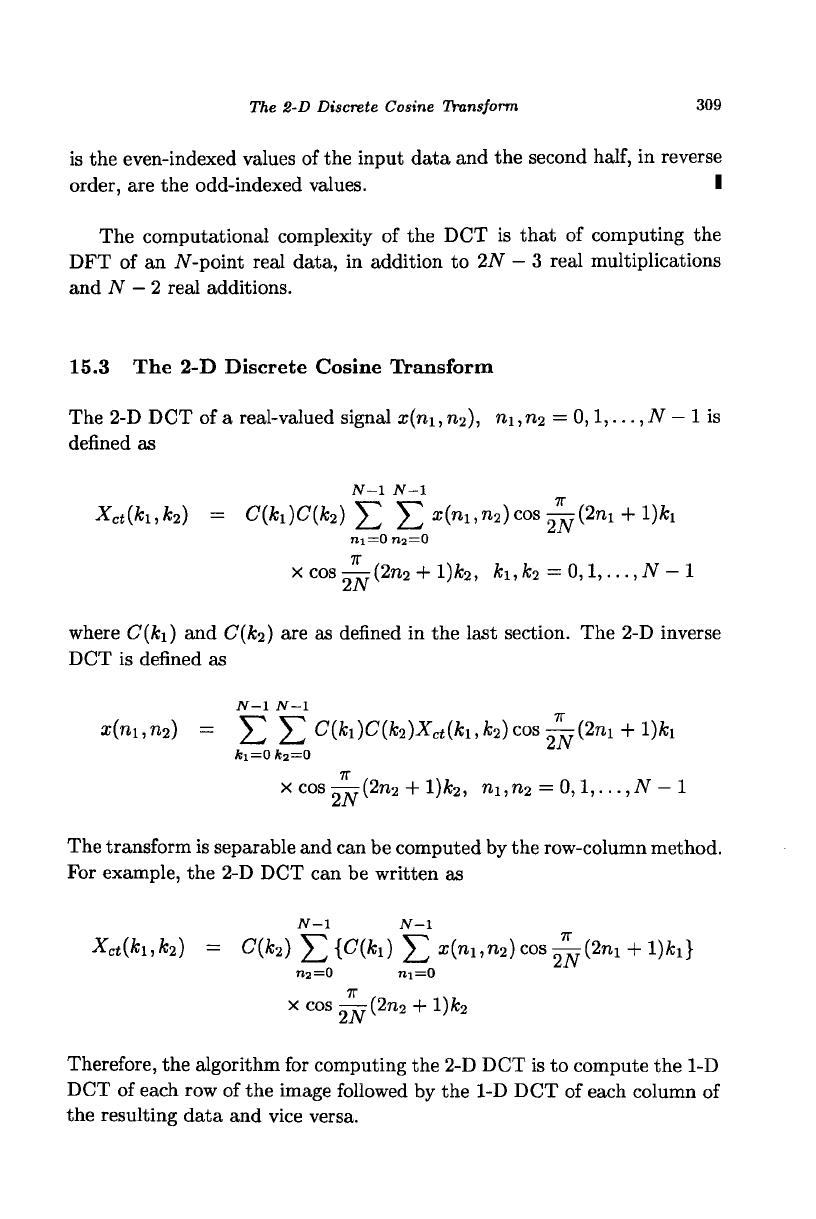
The 2-D Discrete Cosine Transform 309
is the even-indexed values of the input data and the second
half,
in reverse
order, are the odd-indexed values. I
The computational complexity of the DCT is that of computing the
DFT of an TV-point real data, in addition to 2N
—
3 real multiplications
and N
—
2 real additions.
15.3 The 2-D Discrete Cosine Transform
The 2-D DCT of a real-valued signal x(ni, n
2
), n\, n
2
=
0,1,...,
N
—
1 is
defined as
JV-1 JV-1
X
ct
{k
u
k
2
)
= C{k
1
)C{k
2
) ]T 53x(ni,n
2
)co8^(2ni + l)*i
ni=0 ri2=0
7T
x cos—:(2n
2
+ l)fe2, h,k
2
= 0,1, ...,N - 1
where C(fci) and C(k
2
) are as defined in the last section. The 2-D inverse
DCT is defined as
N-l
N-l
x(n
u
n
2
) = Yl Yl C(fci)C(fc2)X
ct
(fci,fc
2
)cos^r(2ni + l)fci
ki=0k
2
=0
7T
x cos—(2n
2
+ l)k
2
, ni,n
2
=
0,1,...,
N - 1
The transform is separable and can be computed by the row-column method.
For example, the 2-D DCT can be written as
N-l JV-1
Xct(k
u
k
2
) = C(fc
2
) £{£(*!) ^x(n
1
,n
2
)cos^(2n
1
+ l)A;
1
}
ri2=o m=o
xcos—(2n
2
+ l)A;
2
Therefore, the algorithm for computing the 2-D DCT is to compute the 1-D
DCT of each row of the image followed by the 1-D DCT of each column of
the resulting data and vice versa.
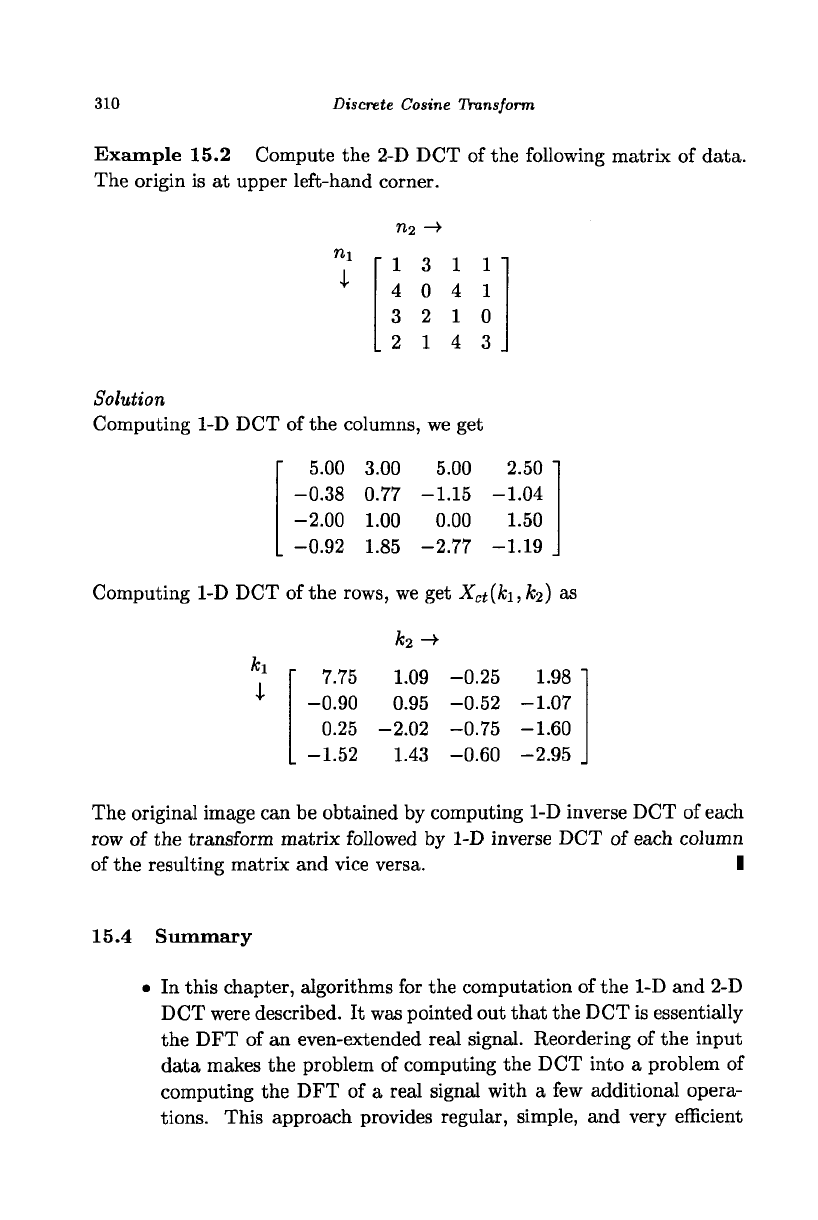
310 Discrete Cosine Transform
Example 15.2 Compute the 2-D DCT of the following matrix of data.
The origin is at upper left-hand corner.
2.50 •
1.04
1.50
1.19 .
Computing 1-D DCT of the rows, we get
X
ct
(ki,
fo) as
1.98 "
1.07
1.60
2.95 .
The original image can be obtained by computing 1-D inverse DCT of each
row of the transform matrix followed by 1-D inverse DCT of each column
of the resulting matrix and vice versa. I
15.4 Summary
• In this chapter, algorithms for the computation of the 1-D and 2-D
DCT were described. It was pointed out that the DCT is essentially
the DFT of an even-extended real signal. Reordering of the input
data makes the problem of computing the DCT into a problem of
computing the DFT of a real signal with a few additional opera-
tions.
This approach provides regular, simple, and very efficient
ni
n
2
-*
13 11
4 0 4 1
3 2 10
2 14 3
Solution
Computing 1-D DCT of the columns, we get
5.00
0.38
2.00
0.92
3.00
0.77
1.00
1.85
5.00
-1.15
0.00
-2.77
k
2
->•
7.75 1.09 -0.25
-0.90 0.95 -0.52
0.25 -2.02 -0.75
-1.52 1.43 -0.60

Exercises
311
DCT algorithms for practical hardware and software implementa-
tions.
References
(1) Guillemin, E. A. (1952) The Mathematics of Circuit Analysis, John
Wiley, New York.
(2) Gonzalez, R. C. and Woods, P. (1987) Digital Image Processing,
Addison Wesley, Reading, Mass.
(3) Jain, A. K. (1989) Fundamentals of Digital Image Processing, Prentice-
Hall, New Jersey.
Exercises
15.1 Compute the DCT,
X
ct
(k),
of x(n) = {3,4,5,6} using the DFT.
Compute x(n) back from
X
c
t(k).
* 15.2 Compute the 2-D DCT of the following matrix of data using the
DFT. The origin is at upper left-hand corner.
n
2
-¥
14 2 3"
5 6 4 1
2 5 13
3 0 4 1
ni
4-

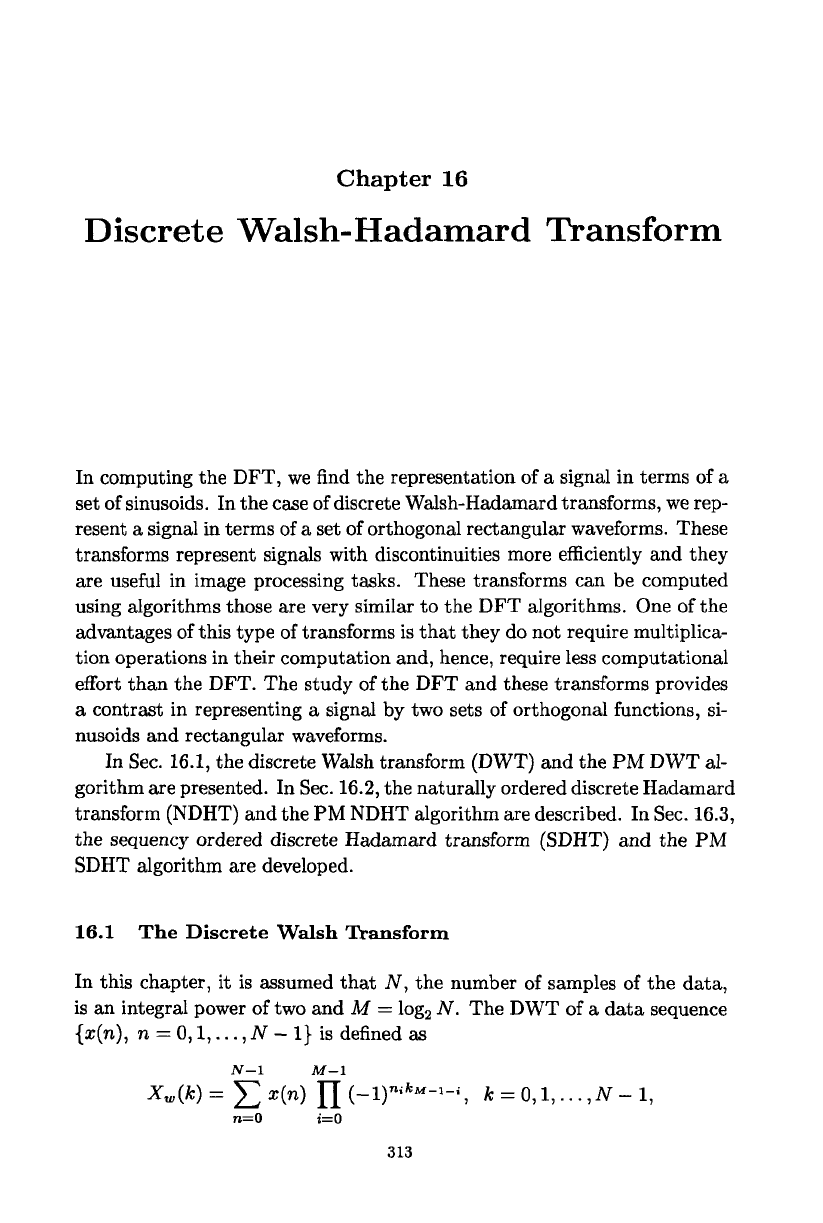
Chapter 16
Discrete Walsh-Hadamard Transform
In computing the DFT, we find the representation of a signal in terms of a
set of
sinusoids.
In the case of discrete Walsh-Hadamard transforms, we rep-
resent a signal in terms of a set of orthogonal rectangular waveforms. These
transforms represent signals with discontinuities more efficiently and they
are useful in image processing tasks. These transforms can be computed
using algorithms those are very similar to the DFT algorithms. One of the
advantages of this type of transforms is that they do not require multiplica-
tion operations in their computation and, hence, require less computational
effort than the DFT. The study of the DFT and these transforms provides
a contrast in representing a signal by two sets of orthogonal functions, si-
nusoids and rectangular waveforms.
In Sec.
16.1,
the discrete Walsh transform (DWT) and the PM DWT al-
gorithm are presented. In Sec. 16.2, the naturally ordered discrete Hadamard
transform (NDHT) and the PM NDHT algorithm are described. In Sec. 16.3,
the sequency ordered discrete Hadamard transform (SDHT) and the PM
SDHT algorithm are developed.
16.1 The Discrete Walsh Transform
In this chapter, it is assumed that N, the number of samples of the data,
is an integral power of two and M = log
2
N. The DWT of a data sequence
{x(n),
n =
0,1,...,
N - 1} is defined as
N-l
M-l
*„(*) = £
x(n)
IJ (-ir*"-*-«, ft =
0,1,...,
AT-1,
n=0 t=0
313
